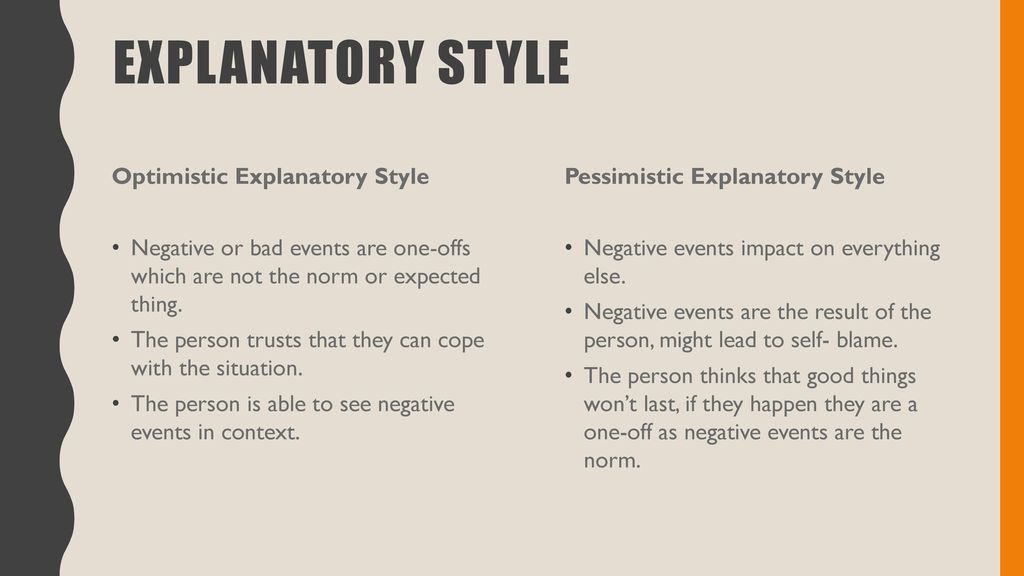Ever been blindsided by life, feeling like it sucker-punched you right in the gut? That was me, not too long ago. A work situation didn’t just give me a bad day; it dragged me into a lingering funk. Imagine starting each day in a mental haze that you just can’t shake—yeah, welcome to my world during that time. So what did I do? I leaned into Positive Psychology. My aim? To find a mental framework to help me understand what was messing with my head, and change how I was seeing my situation. I was wrestling with my own mindset, and the way to win was to get up close and personal with what was holding me back. I had to rewrite my explanatory styles.
Why even bother, you ask? Simple. I wanted to unlock what was messing up my vibe. These negative mindsets and perspectives were more than a nuisance; they were full-on roadblocks, keeping me from feeling and being my best. So, I dug deep, challenging the beliefs that had me stuck in a doom-and-gloom loop. My ultimate goal? To figure out what was anchoring me to this emotional low point, face it head-on, and climb my way back to freedom.
Understanding Explanatory Styles for Emotional Well-Being
Sound familiar? Ever felt like you’re stuck in a cycle where one bad day feels like it’ll define your whole future? Or maybe you’ve had moments where you think all your wins are just luck, but every loss screams you’re not good enough?
If you’re shaking your head ‘yes,’ know you’re not alone. Life doesn’t play fair; it throws curveballs that can trip us up. But here’s the real deal: how you feel about your life—good times and bad—is all about how you interpret what’s happening around you. To really get this, we’ll tap into the work of Martin Seligman, who’s basically the go-to guy for resilience and well-being in the field of Positive Psychology. His books Authentic Happiness and The Hope Circuit shed tremendous light on this subject. As Seligman puts it, “Sometimes the consequences of holding a belief matter more than its truth.”
Let’s break down three ways of explaining what we encounter that trip a lot of us up: The Personal, The Permanent, and The Pervasive. These are known as Explanatory Styles. Once you get these, you’ll see challenges in a whole new light. And who knows? This knowledge could be the game-changer you’ve been waiting for when it comes to your emotional health. It worked for me.

The Permanent Explanatory Style
Is It Really Gonna Last Forever?
Have you ever messed up and thought, “Well, that’s it. I’m always going to be terrible at this”? That’s the explanatory style of permanence. You’re convincing yourself that a single moment defines your forever. But guess what? Life changes. You grow. The only permanent thing is change itself.
The Optimist vs. The Pessimist
Again, optimists and pessimists look at the lifespan of events totally differently. Optimists believe bad times are just temporary hitches, and good times are here to stay. Pessimists, however, think the opposite. They feel like bad times are going to haunt them forever, while good times are fleeting.
When Bad Things Happen
- Pessimistic Mindset: Imagine you’ve had a terrible first date. You might think, “I’ll be forever alone because no one will ever like me.” See how you’re making that one bad date your life sentence?
- Optimistic Mindset: Same bad date, different mindset. An optimist would think, “Well, that was one bad date, but it doesn’t mean all my future dates will be horrible.” That’s the spirit! One bad experience doesn’t set the stage for the rest of your life.
When Good Things Happen
- Pessimistic Mindset: Say you crush it in a game of basketball and think, “Wow, the stars must’ve aligned for me today. This won’t happen again.” If you’re downplaying your success as a one-time thing, you’re missing out on fueling your self-belief for future games.
- Optimistic Mindset: Now, if you dominate that basketball game and think, “I’ve got skills, and I can keep this up,” you’re in optimistic territory. You’re taking that success and making it a building block for the future.
So, the next time you find yourself thinking that a bad moment will last forever or a good one is just a fluke, hit the pause button. Ask yourself if you’re getting caught up in a misaligned permanence-based mindset. Your perspective on time can either weigh you down or set you free. Choose wisely.

The Pervasive Explanatory Style
Is It Really Going to Affect Everything?
You ever have one of those moments where something goes wrong and suddenly you feel like your whole world is crashing down? Like missing a deadline at work and thinking it means you’re bad at your job, your relationships, and life in general? That’s the pervasive explanatory style. You’re letting one single event color your view of everything else.
The Optimist vs. The Pessimist
Optimists and pessimists don’t just differ in how they see the personal or permanent nature of events; they also differ in how wide they cast the net of an event’s impact. Optimists keep things in perspective, confining bad events to their actual size. Pessimists? They let a bad event bleed into every area of their lives.
When Bad Things Happen
- Pessimistic Mindset: Let’s say you mess up a presentation at work. Thinking, “I’m not just bad at presentations, but I’m bad at everything I do,” is a classic example of pervasive thinking. You’re letting one event dictate your view on your entire life.
- Optimistic Mindset: Same situation but a different view. You’d think, “I messed up that presentation, but it doesn’t mean I’m bad at everything.” You’re keeping the bad event confined to its actual size. You’re not letting it invade other parts of your life.
When Good Things Happen
- Pessimistic Mindset: You get a promotion but think, “Well, I may be good at my job, but it doesn’t make me a good person.” With this mindset, you’re not allowing a good thing to lift up other areas of your life.
- Optimistic Mindset: Now, if you get that promotion and think, “I’m not just good at my job, but this shows I can be successful in other areas too,” then you’re letting the good spill over. You’re using one positive event to fuel your confidence in other parts of your life.
Remember, the next time something happens—good or bad—be aware of how wide you’re letting that event cast its net over your life. Is it really going to affect everything? Chances are, it’s not. Keeping the scope of life’s ups and downs in perspective can make a world of difference in how you feel day to day.

The Personal Explanatory Style
What’s about you and what’s not?
You know those moments when something goes wrong and you think, “This is all on me. I messed up.” Like when you don’t land that job you really wanted. Your gut reaction might be to think, “I’m just not good enough,” instead of looking at the whole picture. This is the personal explanatory style. Maybe the company wanted someone with different skills, or maybe they had an internal candidate in mind. The truth is, not every hiccup in life is your fault. Sometimes, things just happen the way they do, and that’s okay.
The Optimist vs. The Pessimist
How you see the good and bad stuff that happens to you can really shape your life. An optimist tends to give themselves credit for good things and doesn’t beat themselves up over the bad stuff. A pessimist? Well, they take the blame for bad things and shrug off the good stuff as just “luck.”
When Bad Things Happen
- Pessimistic Mindset: Let’s say you’re not invited to a friend’s party. If you’re stuck in a pessimistic mindset, you might think, “I must not be likable; that’s why they didn’t invite me.” You’re making it all about you without thinking of other reasons like limited space or different friend circles.
- Optimistic Mindset: In the same situation, an optimist would think, “They probably only invited their work friends; that’s why they didn’t invite me.” See the difference? You’re not blaming yourself. You’re acknowledging other factors like maybe the party had a theme or was for a specific group of people.
When Good Things Happen
- Pessimistic Mindset: You win an award at work but think, “I sure got lucky on this one.” If you brush it off like that, you’re missing out on a chance to boost your own confidence and recognize your hard work.
- Optimistic Mindset: On the flip side, if you win that same award and think, “I earned this because of my hard work and skills,” you’re giving yourself the credit you deserve. You’re acknowledging your efforts, and that’s like a shot of motivational adrenaline right there.
Understanding your mindset can be like flipping a switch on how you experience life. So, the next time you catch yourself falling into the pessimistic trap, remember you have the power to flip that switch. Life’s a lot brighter when you do.

Taking Control of Your Explanatory Styles
Alright, we’ve unpacked a lot here. We’ve looked into those tricky mindset conundrums: The Personal, The Permanent, and The Pervasive. It might seem daunting at first, like trying to climb a mountain with your bare hands. But the good news? You already have the tools you need to start chipping away at these mindset boulders. You’ve got resilience, courage, and now, some extra wisdom to boot.
In the grand tapestry of life, these misaligned perspectives are just threads. They don’t have to define the whole beautiful, intricate pattern that is you. Remember, we’re all a work in progress. We’re all navigating the messy and the magical, sometimes stumbling, but also collecting bits of grace along the way.
A Compass for Resilience & Well-Being
So, the next time you find yourself spiraling down one of these mindset rabbit holes, take a moment to breathe. Just breathe. Ask yourself: “Is this Personal? Is this Permanent? Is this Pervasive?” Then give yourself the permission to see the situation for what it really is, not what your myopic, trap-laden mind wants to make it.
To borrow one more insight from Martin Seligman, “Optimism is invaluable for the meaningful life. With a firm belief in a positive future, you can throw yourself into the service of that which is larger than you are.”
Life’s a journey with bumps, detours, and yes, even some roadblocks. But by recognizing your explanatory styles and dodging these mindset potholes, you’re arming yourself with a compass—a compass that points you toward resilience, well-being, and a life rich with meaning.
In the next article, we’re diving deep into the thinking traps that come from the ways we explain things to ourselves. We’ll also tackle how to break free from these traps that hold us back. Read it here: Thinking Traps: Recognize and Defeat Your Mind’s Pitfalls.

